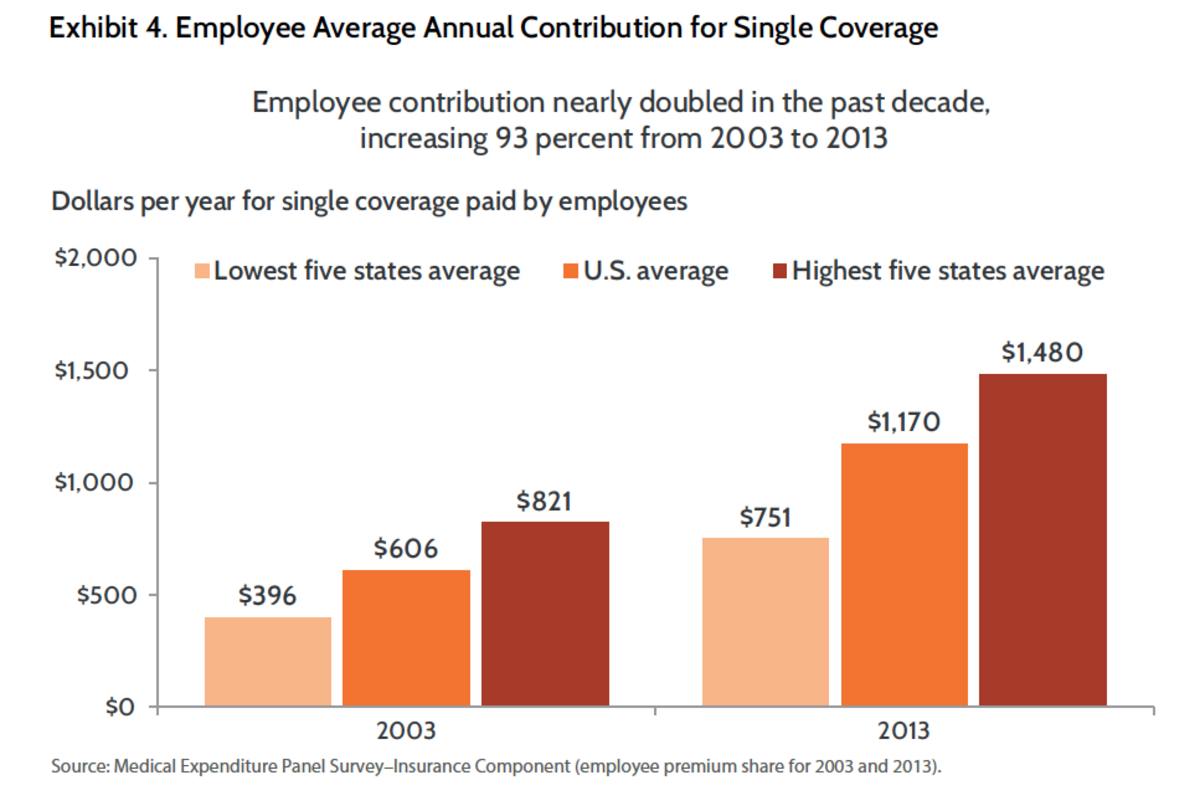Health insurance prices slow, but workers still feel the pinch
Even when there's good news for health insurance prices, workers still can't catch a break.
A slow-down in growth of premium prices for employer-based health insurance in most of the United States in recent years has yet to translate into relief for the people covered by those plans, a new report released Wednesday finds.
The Commonwealth Fund's state-by-state analysis also shows that in every state over the course of a decade, the cost of employer-provided health care still grew faster than incomes.
That, in turn, had led to workers footing a bigger share of the costs of their health insurance.
In fact, employee contributions to their insurance costs have risen by as much as 175 percent since 2003 in some cases—with workers in the south having the biggest cost burden.
"Slow wage growth means working families in every state are being squeezed by health-care costs," said Sara Collins, the report's co-author and vice president for health-care coverage and access at the Commonwealth Fund.
The report comes after years of slow growth in overall health-care costs on the heels of the 2008 financial meltdown, and as the effects of President Barack Obama's health-care reform law, the Affordable Care Act, are being felt. The ACA contains several provisions designed to slow the rate of health-care cost growth.
The report notes that from 2010 to 2013, on the heels of the ACA's passage, 31 states and the District of Columbia saw a slowdown in the growth of premiums charged for health insurance for workers. Twelve of those states saw at least a three-percentage-point decrease in the rate of premium inflation.
But from 2003 through 2013, in all states, the price of employer-provider insurance premiums grew quicker than the pay for the workers there.
Because of that, "from an employee and family perspective, there may be little awareness that premium growth has slowed," said Cathy Schoen, one of the authors of the study, which includes an interactive map that highlights the state-based data.
The effect of that difference in inflation rates is underscored by the fact that in 2003 there were only two states, New Mexico and West Virginia, where average premiums equaled 20 percent or more of the median income in those states.
But by 2013, "average premiums amounted to 20 percent or more of the median income in all but 13 states and the District of Columbia," according to the Commonwealth Fund.
And in seven states as of 2013—Alaska, Arkansas, Kentucky, Nevada, New Mexico, Texas and West Virginia—"average premiums were 25 percent to 28 percent of of state median income in 2013," the group said.
"Premiums relative to incomes are particularly high in Southern states," according to the Commonwealth Fund. "Average total premiums equaled 22 percent or more in 12 Southern states."
Those average premiums nationally—which range from about $13,500 to $14,382 annually at the low end, up to between $17,262 to $20,715 at the high end—represent the total premium payments by both employers and employees to the health plans.
But during the same decade-long period eyed by the Commonwealth Fund, workers ended up paying more personally for their coverage, both in the form of premiums and deductibles, the portion of medical costs that have to be paid by the enrollee before the insurance pays its share of the bill.
"In every state, employees contributions to their health insurance premiums in 2013 amount to a higher share of state median income than a decade earlier," the Commonwealth Fund said. "In 15 states, employees annual payment for their share of premiums rose by 100 percent or more."
On the deductible side of the equation, the report noted that in 2003, no state had an average deductible for employer plans that was as high as $1,000. A decade later, the average-per-person deductible in such plans topped $1,000 "in all but three states and the District of Columbia." Deductibles, over the same time period, at least doubled in all but six states, and the District of Columbia.
The combined out-of-pocket premiums and deductibles borne by workers in employer plans range from a low of 6 to 7 percent of the median income in the District of Columbia, Hawaii and North Dakota, to 12 percent or more of median income in Texas and Florida.
Commonwealth Fund President Dr. David Blumenthal said those out-of-pocket costs are "of concern since research shows that high health-care cost burdens relative to income may lead people to avoid seeking needed health care."










